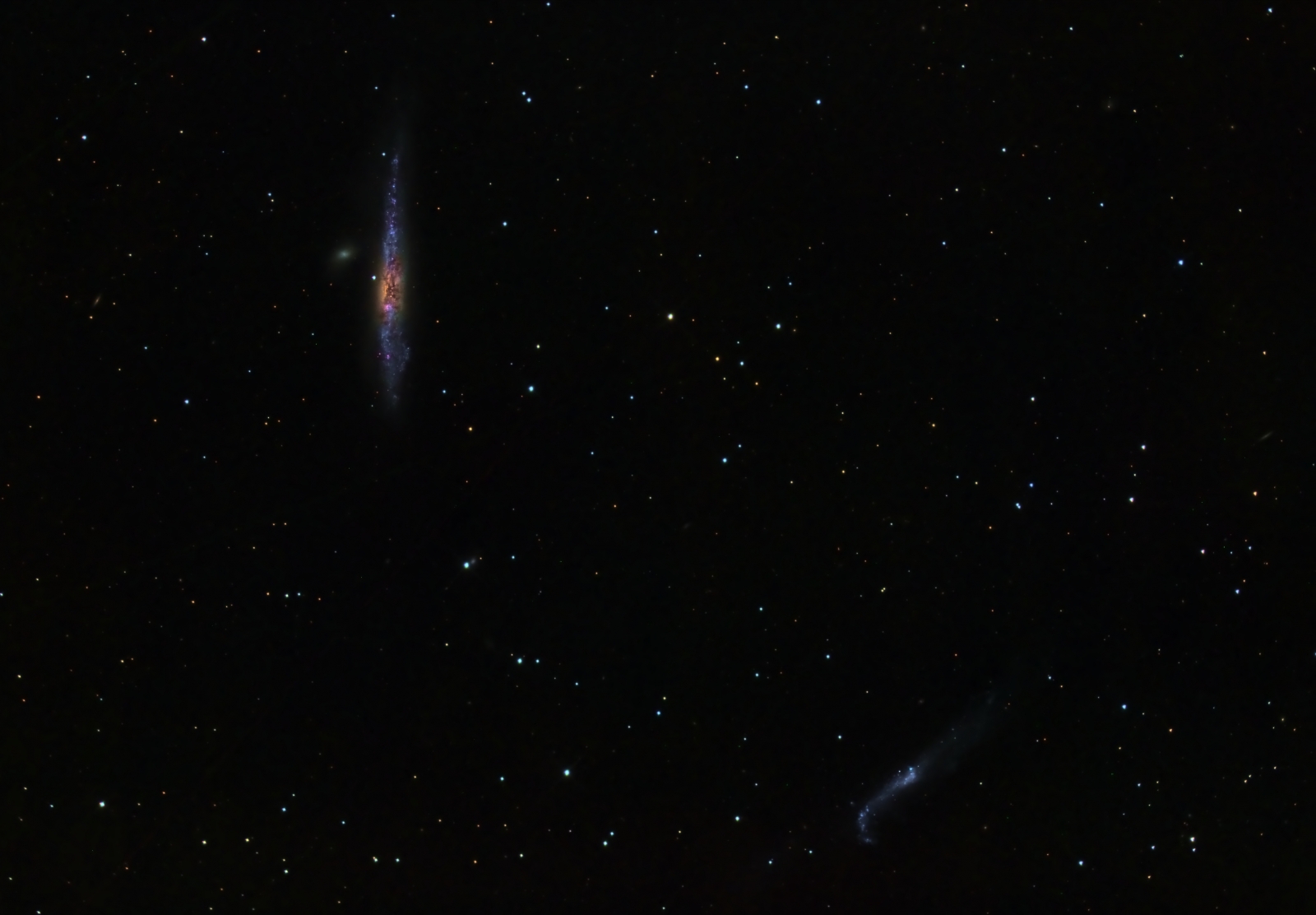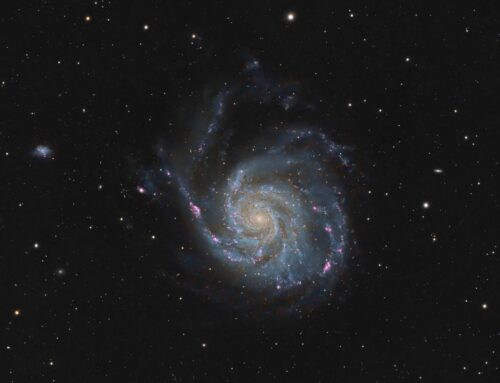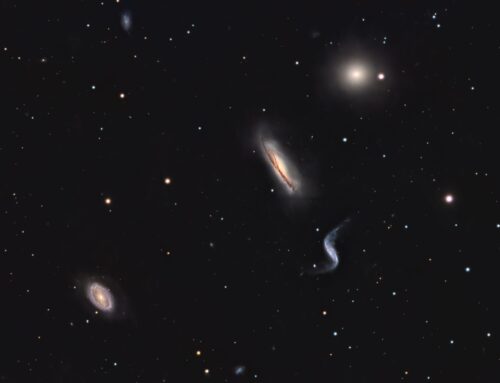Whale and Hockey Stick Galaxies
Click image for full size version
February 20, 2016
NGC4631 (top left) and NGC 4656 (bottom right) are known as the Whale Galaxy and Hockey Stick Galaxy, respectively. The Whale is distorted due to its interaction with NGC4627 just to its left. The Whale shows a yellow core, blue star clusters and pink nebula. It is about 25 million light years away. The Hockey Stick, lying about 30 million light years distant, is distorted by a small galaxy just of the tip of the “blade.” In this region of sky there are galaxies everywhere, and you can find many more in this picture. Look for streaks (e.g. above centre left, and centre right) or fuzzy patches that don’t look like the other stars. I acquired the data in 2014, and this version replaces the one previously posted here, for those who are interested in seeing how my processing has changed over time. I think this shot would benefit from a lot more imaging time, and I plan to go back to it this spring.
Tekkies:
SBIG STL-11000M camera, Baader RGB filters, 10″ f/6.8 ASA astrograph, Paramount MX. Guided with STL-11000’s internal guider. Focused with FocusMax. Acquisition, guiding and calibration with MaximDL. Image registration and all processing in PixInsight. Shot from my SkyShed in Guelph, Ontario. Thin crescent moon. Average transparency and seeing throughout.
10x15m R, 5x15m G, and 10x15m B, all unbinned frames (total=6hr15m).
RGB
Creation and cleanup: R, G and B masters were combined with ChannelCombination, and the resulting RGB image was cropped and processed with DBE, followed by ColorCalibration.
Linear Noise Reduction: MultiscaleLinearTransform was used to reduce noise in the background areas of the RGB image. Layer settings for threshold and strength: Layer 1: 3.0, 0.5 Layer 2: 2.0, 0.39 Layer 3: 1.0, 0.25 Layer 4: 0.5, 0.1. A mask was used to protect high signal areas.
Stretching: HistogramTransformation was applied to make a pleasing yet bright RGB image.
Synthetic Luminance
Creation and cleanup: The R,G and B masters were combined using the ImageIntegration tool (average, additive with scaling, noise evaluation, iterative K-sigma / biweight midvariance, no pixel rejection) to create the SynthL channel. The image was cropped to match the RGB and DBE was applied.
Deconvolution: A copy of SynthL was stretched to use as a deconvolution mask. A star mask was made from unstretched SynthL to use as a local deringing support. Deconvolution was applied (100 iterations, regularized Richardson-Lucy, external PSF made using DynamicPSF tool with about 20 stars; local deringing at 70% and global dark deringing at 0.03).
Linear Noise Reduction: MultiscaleLinearTransform was applied to reduce the noise. Layer settings for threshold and strength: Layer 1: 3.0, 0.6 Layer 2: 2.0, 0.5 Layer 3: 1.0, 0.4 Layer 4: 0.5, 0.15
Stretching: HistogramTransformation was applied to make an image with similar brightness to the RGB image. TGVDenoise was applied and the image was re-stretched to reset the black point.
Combining SynthL with RGB:
The luminance channel of the RGB image was extracted, processed and then added back into the RGB image as follows:
1. Set RGB channels equal using RGBWorkingSpace.
2. Extract luminance from the RGB image.
3. Apply LinearFit using SynthL as the reference.
4. Use ChannelCombination in Lab mode to replace the RGB’s luminance with the fitted luminance from step 2.
5. LRGBCombine was then used to make a SynthLRGB image.
Final Processing
UnsharpMask was applied to the galaxies using a range mask to protect background and stars. Contrast, brightness and colour saturation were adjusted in several iterations with the Curves tool, with separate adjustments made for galaxy, background and stars using a mask.
Image scale is about 1.1 arcsec per pixel for this camera / telescope combination.







Excellent, what a website it is! This web site provides useful information to us,
keep it up.